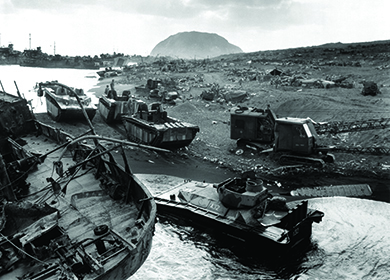| << Chapter < Page | Chapter >> Page > |
In the Pacific, MacArthur and the Allied forces pursued an island hopping strategy that bypassed certain island strongholds held by the Japanese that were of little or no strategic value. By seizing locations from which Japanese communications and transportation routes could be disrupted or destroyed, the Allies advanced towards Japan without engaging the thousands of Japanese stationed on garrisoned islands. The goal was to advance American air strength close enough to Japan proper to achieve air superiority over the home islands; the nation could then be bombed into submission or at least weakened in preparation for an amphibious assault. By February 1945, American forces had reached the island of Iwo Jima ( [link] ). Iwo Jima was originally meant to serve as a forward air base for fighter planes, providing cover for long-distance bombing raids on Japan. Two months later, an even larger engagement, the hardest fought and bloodiest battle of the Pacific theater, took place as American forces invaded Okinawa. The battle raged from April 1945 well into July 1945; the island was finally secured at the cost of seventeen thousand American soldiers killed and thirty-six thousand wounded. Japanese forces lost over 100,000 troops. Perhaps as many as 150,000 civilians perished as well.

All belligerents in World War II sought to develop powerful and devastating weaponry. As early as 1939, German scientists had discovered how to split uranium atoms, the technology that would ultimately allow for the creation of the atomic bomb. Albert Einstein, who had emigrated to the United States in 1933 to escape the Nazis, urged President Roosevelt to launch an American atomic research project, and Roosevelt agreed to do so, with reservations. In late 1941, the program received its code name: the Manhattan Project . Located at Los Alamos, New Mexico, the Manhattan Project ultimately employed 150,000 people and cost some $2 billion. In July 1945, the project’s scientists successfully tested the first atomic bomb.
In the spring of 1945, the military began to prepare for the possible use of an atomic bomb by choosing appropriate targets. Suspecting that the immediate bomb blast would extend over one mile and secondary effects would include fire damage, a compact city of significant military value with densely built frame buildings seemed to be the best target. Eventually, the city of Hiroshima, the headquarters of the Japanese Second Army, and the communications and supply hub for all of southern Japan, was chosen. The city of Kokura was chosen as the primary target of the second bomb, and Nagasaki, an industrial center producing war materiel and the largest seaport in southern Japan, was selected as a secondary target.
The Enola Gay , a B-29 bomber named after its pilot’s mother, dropped an atomic bomb known as “Little Boy” on Hiroshima at 8:15 a.m. Monday morning, August 6, 1945. A huge mushroom cloud rose above the city. Survivors sitting down for breakfast or preparing to go to school recalled seeing a bright light and then being blown across the room. The immense heat of the blast melted stone and metal, and ignited fires throughout the city. One man later recalled watching his mother and brother burn to death as fire consumed their home. A female survivor, a child at the time of the attack, remembered finding the body of her mother, which had been reduced to ashes and fell apart as she touched it. Two-thirds of the buildings in Hiroshima were destroyed. Within an hour after the bombing, radioactive “black rain” began to fall. Approximately seventy thousand people died in the original blast. The same number would later die of radiation poisoning. When Japan refused to surrender, a second atomic bomb, named Fat Man, was dropped on Nagasaki on August 9, 1945. At least sixty thousand people were killed at Nagasaki. Kokura, the primary target, had been shrouded in clouds on that morning and thus had escaped destruction. It is impossible to say with certainty how many died in the two attacks; the heat of the bomb blasts incinerated or vaporized many of the victims ( [link] ).

Notification Switch
Would you like to follow the 'U.s. history' conversation and receive update notifications?